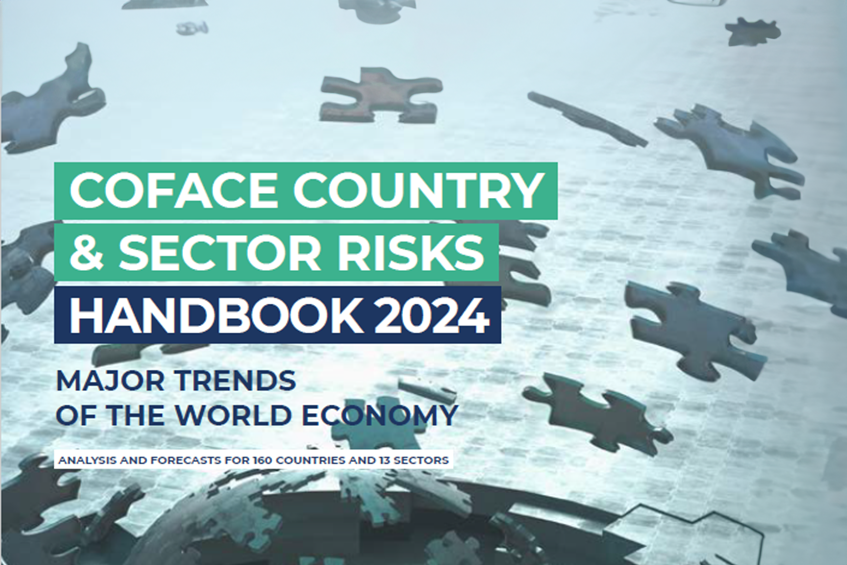Coface launches the 2024 edition of its Country and Sector Risk Handbook. As every year, our Economic Research team offers you its analyses and forecasts for 160 countries and 13 sectors.
In his foreword, Coface CEO Xavier Durand summarizes the major risks of 2024.
2024, back to normal?
Ultimately, 2023 was not the annus horribilis we had feared. Fortunately, the risks, most notably in terms of energy supply, did not materialise - in Europe at least. The global economy is expected to have grown by around 2.5%. While still below its potential, this performance is nonetheless decent given the headwinds that once again blew in over the year. We should remember that 2023 began with a banking crisis in the United States and ended with a new conflict, this time in the Middle East. In the meantime, China disappointed, the United States convinced, and Europe survived in a somewhat turbulent monetary and financial environment. In contrast to investors’ expectations, the main central banks continued to raise their key rates (+100 basis points for the Federal Reserve, +175 for the Bank of England, +200 for the European Central Bank), triggering a severe contraction in lending and a sharp rise in long-term interest rates. This was not enough to upset the equity markets, which were fundamentally supported by the resilience of business activity and corporate margins. The faster-than-expected fall in inflation due to lower commodity prices and, at the very end of the year, the prospect of major central banks significantly lowering their key interest rates also contributed to this momentum.
The main reason for the better-than-expected outcome in 2023 is the initially underestimated resilience of private agents’ balance sheets. This ‘balance sheet resilience’ has been at the root of a virtuous circle combining, until now, low corporate losses, resilient employment, and household dissaving. This was particularly the case in the United States, where consumption remained an engine of growth (accounting for 1.5 points of GDP in 2023, with GDP growth estimated at around +2.5%). However, the latest figures suggest that this fine mechanism is starting to jam. Excess savings and cash flow have dwindled significantly, while corporate insolvencies are firmly on the rise, both in terms of frequency and the size of the claims concerned.
Download our Country and Sector Risk Handbook
How will 2024 unfold?
Right off the bat: the only certainty we can have is that of being surprised. The events in recent years have shown that history is accelerating, and it would be strange if 2024 were an exception. All the more so as the year will be particularly busy from an electoral standpoint, with legislative and/or presidential elections scheduled in 70 countries that account for over half the world’s population and GDP: between Taiwan a few weeks ago and the United States in November, voters will be called to the polls in India, Pakistan, South Africa and Iran... not to mention the European elections to be held next spring, against a backdrop of heightened social tensions and the rise of populism of all kinds. This should cause a few upheavals at national level, in a geopolitical context that is still in turmoil: the war in Ukraine is entering its third year, and the conflict between Israel and Hamas now threatens to set the whole region ablaze.
The events in recent years have shown that history is accelerating, and it would be strange if 2024 were an exception.
From a strictly macroeconomic point of view, the hope of a prolonged but still soft landing for the global economy remains valid. While a few months ago we feared the onset of severe market turbulence, the easing of financial conditions means that we can look forward to the year ahead more calmly. Our central scenario therefore rules out the hypothesis of a financial crash and a hard landing. Nevertheless, the global economy is set to slow substantially, losing almost half a percentage point of growth compared with last year (+2.2%). Most of this slowdown will come from the major developed economies that outperformed in 2023 - led by the United States, whose growth is still expected to exceed +1% - but also from China (+4.3%), whose growth model is struggling to rebalance, and which still must purge the excesses of the past (property development, manufacturing overcapacity, etc.). Europe, for its part, should accelerate slightly under the effect of the expected (and hoped-for) rebound of the German economy, although growth on the Old Continent will remain below its potential (+0.9%). Lastly, the weakening of the dollar and interest rates should give some breathing room to emerging economies faced with constraints on access to external (re) financing. Yet nothing is guaranteed, and our central scenario is more like a ridge than a boulevard. In terms of inflation, for the time being, the downturn remains essentially linked to base effects on energy prices and the fall in goods prices, against a backdrop of a rebalancing of consumption towards services and a normalisation of supply chains. The challenge in 2024 will be to determine whether the monetary tightening that has been underway for over 18 months is sufficient to achieve more than this mechanical disinflation, and to go the ‘last mile’ to bring inflation back to 2%. The buoyancy of services prices, still up by 4-5% year-on-year, suggests that the battle is well under way but not yet won.
In any case, barring an accident, central banks will not be cutting their key rates as quickly and as aggressively as they raised them. Similarly, long-term interest rates are unlikely to return to where they stood over the last fifteen years anytime soon. In other words, the latent conflict of objectives in most developed countries between broadly restrictive monetary policies on the one hand, and expansionary fiscal policies on the other, will remain a major source of instability.
The twenty-eighth edition of this handbook covers all these questions and attempts to provide answers by adopting, as usual, a dual geographical and sectoral approach. I wish everyone an enjoyable read of this document, which Coface publishes every year.



